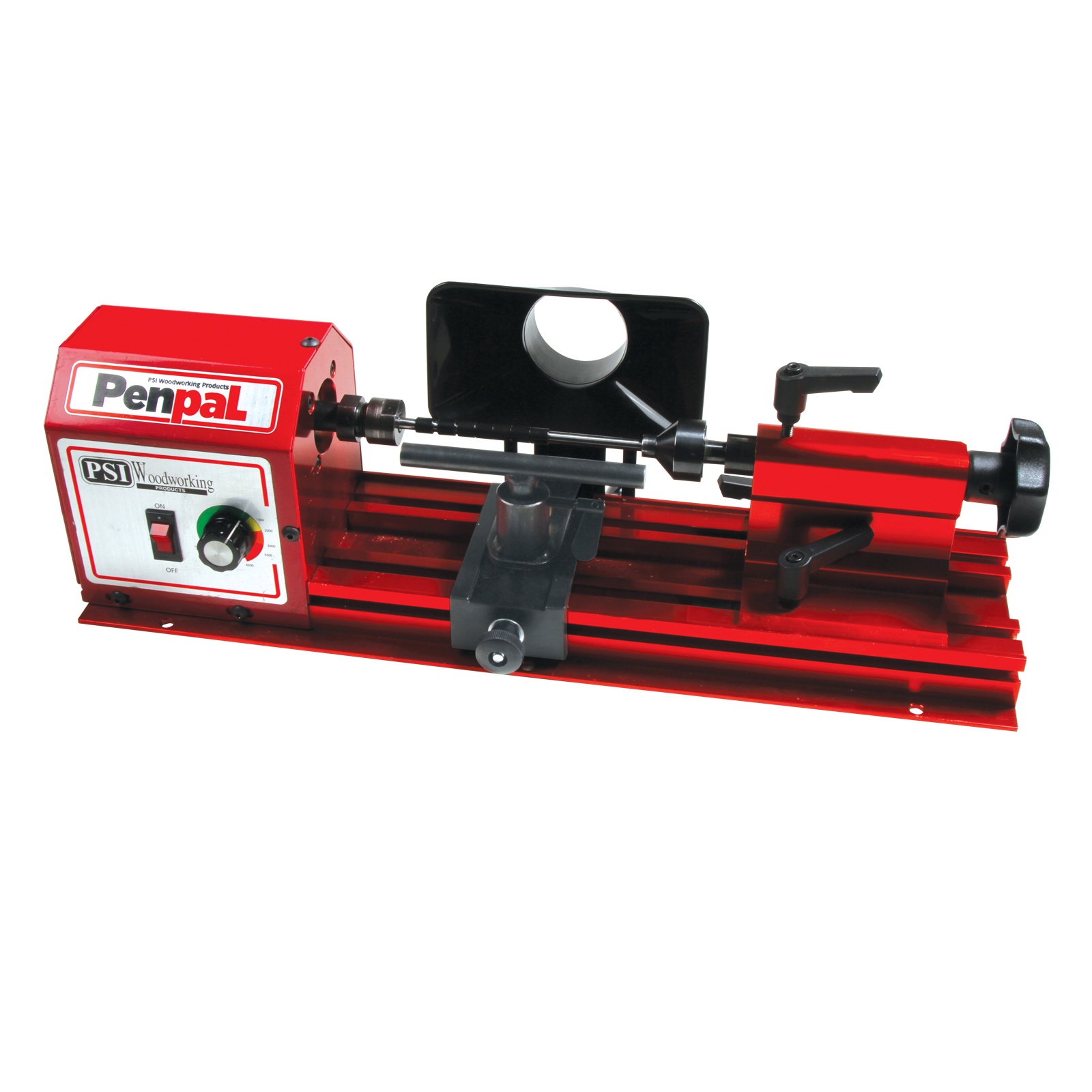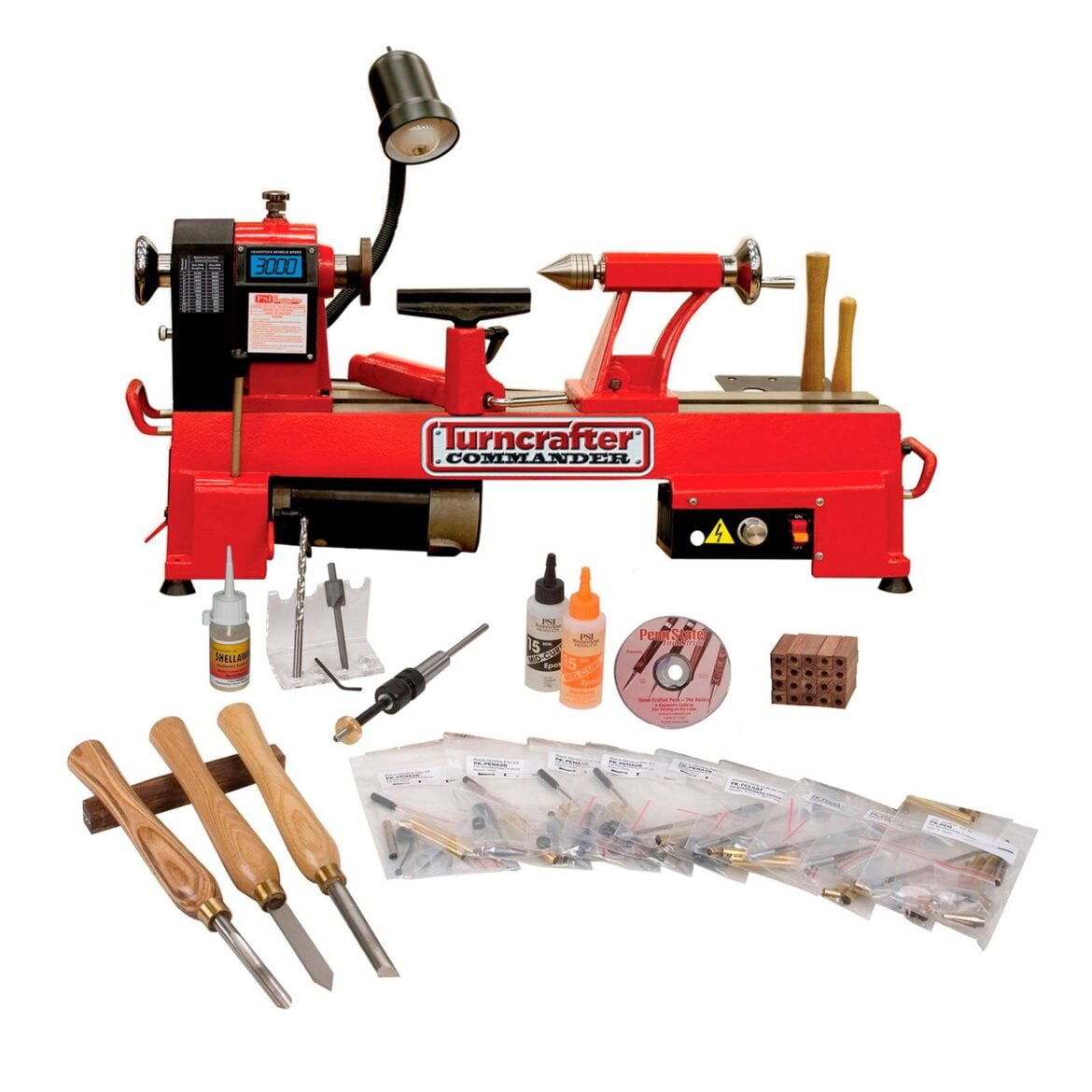Table of Contents
A lathe for pen turning is a specialized tool used to shape and finish pen blanks. It provides precision and control.
Pen turning is a popular hobby among woodworkers and craft enthusiasts. This craft involves using a lathe to transform pen blanks into beautifully crafted writing instruments. Lathes designed for pen turning are compact and user-friendly, making them ideal for both beginners and experienced turners.
These lathes offer adjustable speeds and precise control, ensuring smooth and accurate results. Selecting the right lathe is crucial for achieving high-quality pens. Features such as stability, ease of use, and durability play a significant role. With the right lathe, you can create unique, personalized pens that showcase your craftsmanship and creativity.

Credit: www.youtube.com
Introduction To Pen Turning
Pen turning is a fun and creative hobby. It allows you to make beautiful and unique pens. Using a lathe, you can shape and design wood or acrylic blanks. Each pen you create will be special and one-of-a-kind. The process requires focus and attention to detail. This makes it a rewarding and satisfying activity.
A lathe is a key tool for pen turning. It helps you shape the pen blanks with precision. You can achieve smooth and even surfaces. Lathes come in various sizes, making them suitable for different projects. They provide stability and control, ensuring consistent results. Investing in a quality lathe will enhance your pen turning experience.
Types Of Lathes For Pen Turning
Mini and Midi lathes are great for pen turning. They are small and easy to use. Mini lathes are perfect for beginners. Midi lathes are a bit bigger and offer more power. Both types are portable and fit well in small spaces. They are also affordable.
Benchtop lathes are larger than Mini and Midi lathes. They provide more stability and power. These lathes are perfect for more serious pen turners. They can handle bigger projects too. Benchtop lathes are still compact enough to fit on a workbench. They are a good middle-ground option.
Full-size lathes are the biggest and most powerful. They offer the most features and capabilities. These lathes are ideal for professional woodworkers. They can handle very large projects. Full-size lathes require more space and are less portable. They are the most expensive option.
Key Features To Consider
Essential features for a lathe for pen turning include variable speed control, precise tailstock, and durable construction. Compact size and ease of use enhance efficiency, making pen turning a seamless experience.
Variable Speed Control
Variable speed control is important for pen turning. It lets you adjust the speed of the lathe. This helps in achieving a smooth finish. Different materials need different speeds. Wood and acrylics turn better at different speeds.
Swing Capacity
The swing capacity of a lathe is crucial. It tells you the maximum diameter of work you can turn. For pen turning, a smaller swing capacity is enough. Most pen blanks are not very wide. Always check the swing capacity before buying.
Distance Between Centers
The distance between centers is another key feature. It indicates the maximum length of the workpiece. For pen turning, this distance should be sufficient for pen blanks. Usually, a distance of 12-15 inches is ideal. Make sure the lathe fits your project needs.

Credit: www.pennstateind.com
Setting Up Your Lathe
Setting up your lathe for pen turning ensures smooth, precise cuts. Align the tailstock and secure the blank properly. Adjust the tool rest for optimal control and safety.
Workspace Preparation
Choose a clean, well-lit area for your lathe. Make sure the space is organized and free of clutter. Good lighting is crucial for seeing details. Keep your tools within easy reach. Use a sturdy table or bench to place your lathe. Ensure the surface is level and stable. Safety gear like goggles and gloves should be nearby. A dust collection system helps keep the area clean. Proper ventilation is also important.
Lathe Assembly And Maintenance
Read the manual before assembling your lathe. Follow the instructions step by step. Tighten all screws and bolts properly. Check the lathe for any loose parts. Lubricate moving parts as needed. Regular maintenance keeps the lathe running smoothly. Clean the lathe after each use. Inspect the belts and replace if worn out. Keep the lathe’s bed and tailstock clean. Proper care extends the life of your lathe.
Selecting Pen Blanks And Materials
Choosing the right pen blanks and materials is crucial for successful pen turning on a lathe. Opt for high-quality wood, acrylic, or hybrid blanks to ensure smooth turning and a polished finish.
Wood And Acrylic Blanks
Wood blanks come from different trees. Each type of wood has a unique look. Oak and maple are popular choices. They are strong and easy to work with. Wood blanks can be painted or stained. This makes them even more special.
Acrylic blanks are another option. They come in many colors and patterns. Acrylic is durable and shiny. It does not crack easily. These blanks are perfect for colorful pens.
Alternative Materials
Some people use alternative materials for pen blanks. These include bone, antler, and metal. Bone and antler give a natural feel. Metal blanks are strong and modern. Each material offers a different look and feel. Trying new materials can be fun.
The Pen Turning Process
Start by selecting a good pen blank. Cut the blank to the correct length. Use a drill press to make a hole through the center. Insert the brass tube inside the hole. Ensure the tube fits snugly. Apply glue to hold the tube in place. Let the glue dry completely. Mount the blank on the lathe securely. Check that the blank is centered.
Begin with a roughing gouge. Shape the blank into a cylinder. Switch to a skew chisel for finer cuts. Shape the pen to your desired design. Keep the tools sharp for smooth cuts. Work slowly and carefully. Use calipers to measure thickness. Maintain even pressure while turning. Avoid deep cuts to prevent splintering.
Start sanding with coarse grit paper. Gradually move to finer grits. Sand evenly to remove tool marks. Wipe the pen with a clean cloth. Apply a wood finish of your choice. Buff the finish for a glossy look. Repeat the finish application if needed. Let the pen dry thoroughly before assembly.
Advanced Pen Turning Techniques
Master the art of pen turning with advanced lathe techniques. Achieve precision and creativity in crafting stunning, custom pens. Elevate your woodworking skills with the right lathe setup.
Decorative Elements
Adding inlays can make your pen unique. Use thin strips of wood or metal. These strips are placed into cuts made in the pen blank.
Segmentation involves cutting the blank into pieces. Each piece can be a different type of wood. Glue these pieces back together before turning. This creates beautiful patterns.
Troubleshooting Common Issues
Tool chatter happens when the tool vibrates. This can ruin your pen. Keep your tools sharp. Dull tools cause chatter. Use steady pressure. Pressing too hard makes chatter worse. Check the lathe speed. Slow speed can help reduce chatter. Tool rest should be close to the work. This helps control the tool better.
Cracks and breaks can spoil your pen. Choose good quality wood. Poor wood cracks easily. Avoid over-tightening. Too much pressure can cause breaks. If a crack appears, use glue to fix it. Sand the area smooth after gluing. This helps hide the crack. Slow down when cutting near knots. Knots can cause breaks.
Lathe Accessories And Upgrades
Mandrels are crucial for pen turning. They hold the pen blanks securely. Bushings help in shaping the pen accurately. They ensure the right size and alignment. Using the right bushings makes the process easier. Mandrels come in different sizes. Choose one based on your pen kit. Proper alignment is key for a smooth finish.
Tool rests support your cutting tools. They should be adjustable for better control. A good tool rest improves precision. Tailstock live centers hold the pen blank steady. They reduce vibrations during turning. Live centers ensure the blank stays in place. Both accessories enhance your turning experience.

Credit: www.youtube.com
Projects And Inspiration
Handcrafted pens are a joy to create. Each pen is unique and special. Some pens have beautiful wood grains. Others have colorful resins. The designs can be simple or complex. There is no limit to creativity. Many people love to collect these pens.
A gallery can show off your best work. It’s a great way to share with others. Friends and family will be impressed. You might even inspire someone to start pen turning. Sharing your work can lead to new ideas and projects.
The pen turning community is very welcoming. Many people enjoy sharing tips and tricks. You can learn a lot from others. There are online forums and local clubs. These groups can help you improve your skills. You can also make new friends.
Joining a community can be very rewarding. You get support and encouragement. People will celebrate your successes. They can also help you with challenges. Being part of a group makes pen turning even more fun.
Safety Tips For Pen Turning
Always wear safety goggles to protect your eyes. Use ear protection to guard against loud noises. A dust mask helps keep harmful particles out of your lungs. Gloves protect your hands but ensure they are not loose. Aprons or protective clothing shield your body from flying debris. Never forget your face shield for extra protection.
Ensure the lathe is on a stable surface. Check that all tools are sharp and in good condition. Always secure the pen blank tightly. Keep your hands away from the moving parts. Stop the lathe before making adjustments. Maintain a clean work area. Do not wear loose clothing that can get caught. Be sure to work in a well-lit space. Always disconnect the power when not in use.
Conclusion: Crafting Masterpieces
Master the art of pen turning with a lathe. Create unique, handcrafted pens that showcase your craftsmanship and creativity. Achieve precision and elegance in every piece.
The Satisfaction Of Handmade Pens
Creating handmade pens brings joy. Each pen is unique and special. The process is calming and fun. Using a lathe for pen turning is rewarding. You can see your progress quickly. Holding a pen you made feels great. It is a special achievement.
Resources For Continued Learning
Many books and videos can help you. Online forums are also useful. You can ask questions and get tips. Classes are available in many areas. Joining a local club is a good idea. Learning new skills keeps the hobby exciting. Never stop exploring new techniques.
Frequently Asked Questions
What Is The Best Lathe For Pen Turning?
The best lathe for pen turning is the Jet JWL-1015. It offers precision, durability, and ease of use for beginners and experts.
What Do I Need To Turn Pens On A Lathe?
To turn pens on a lathe, you need a lathe machine, pen blanks, turning tools, bushings, and sandpaper.
What Speed Is A Pen Turning Lathe?
A pen turning lathe typically operates at speeds between 3,000 and 4,000 RPM. Adjust the speed based on material.
Can You Turn Pens On A Midi Lathe?
Yes, you can turn pens on a MIDI lathe. Ensure you use the correct tools and techniques for precise results.
Conclusion
Choosing the right lathe for pen turning enhances your crafting experience. A good lathe ensures precision and ease. Invest wisely in a lathe that meets your needs. Quality tools result in beautiful, professional pens. Start your pen turning journey with confidence and creativity.
Happy turning!
